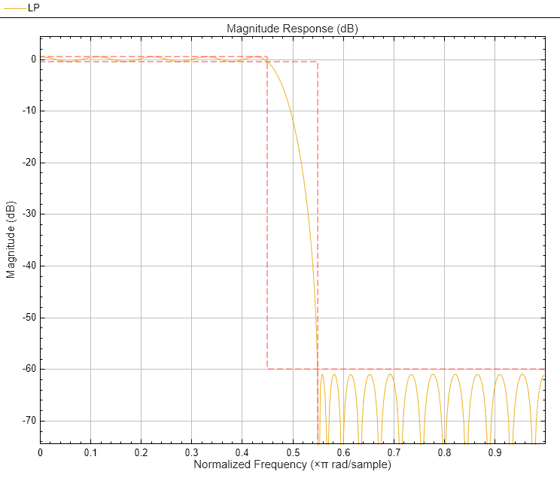replaceFilters
Description
replaceFilters(
replaces all the filters in the Filter Analyzer app
fa,filt1,...,filtn)fa with new filters. The number of specified filters must be equal to
the total number of filters currently in the app. If you want to replace only a subset of
the filters, use the FilterNames argument to specify which ones.
replaceFilters(___,
specifies options using name-value arguments in addition to the input arguments from the
previous syntax.Name=Value)
Examples
Start the Filter Analyzer app with one lowpass filter.
d1 = designfilt("lowpassfir", ... PassbandFrequency=0.45,StopbandFrequency=0.55); fa = filterAnalyzer(d1,FilterNames="LP");

Replace the lowpass filter with a highpass filter.
d2 = designfilt("highpassfir", ... PassbandFrequency=0.55,StopbandFrequency=0.45); replaceFilters(fa,d2,FilterNames="LP") renameFilters(fa,"LP","HP")

Input Arguments
Filter Analyzer app handle, specified as a filterAnalyzer
object.
Input filters, each specified as a pair of coefficient matrices,
a cell array, or a digitalFilter object.
For more information, see Import Filter on the Filter Analyzer page..
Example: b = [1 3 3 1]/6 and a = [3 0 1
0]/3 together specify a third-order lowpass Butterworth filter with a
normalized 3-dB frequency of 0.5π rad/sample.
Example: sos2ctf([2 4 2 6 0 2; 3 3 0 6 0 0]) specifies a
third-order lowpass Butterworth filter with a normalized 3-dB frequency of
0.5π rad/sample.
Example: d =
designfilt("lowpassiir",FilterOrder=3,HalfPowerFrequency=0.5) specifies
a third-order lowpass Butterworth filter with a normalized 3-dB frequency of
0.5π rad/sample.
Filter Coefficients
You can use Filter Analyzer to analyze filters specified as numerator and denominator coefficients. If you specify the coefficients as the L-row matrices
Filter Analyzer assumes you have specified the filter as a sequence of L cascaded transfer functions (CTF), such that the full transfer function of the filter is
where m ≥ 0 is the numerator order of the filter and n ≥ 0 is the denominator order.
If L = 1, then B and A are row vectors that specify the transfer function of an IIR filter.
If you specify both B and A as column vectors, Filter Analyzer assumes they represent the transfer function of an IIR filter.
If B is a scalar, Filter Analyzer assumes you specified the filter as a cascade of all-pole IIR filters with each section having a scaling gain equal to B.
If A is a scalar, Filter Analyzer assumes you specified the filter as a cascade of FIR filters with each section having a scaling gain equal to 1/A.
Note
Coefficients and Gain
If you have a scaling gain separate from the coefficient values, you can enter it
in Filter Analyzer using the Import Filters dialog box. At the command
line, you can specify the coefficients and gain as a cell array of the form {B,A,g}, where B and A are as
defined in the Filter Coefficients section.
The gain can be a scalar overall gain or a vector of section gains.
If the gain is a scalar, Filter Analyzer applies the value uniformly to all the cascade filter sections.
If the gain is a vector, it must have one more element than the number of filter sections in the cascade. Filter Analyzer applies a scale value to each of the filter sections and applies the last value uniformly to all the filter sections.
If you specify the coefficient matrices and gain vector as
Filter Analyzer uses the transfer function
digitalFilter Objects
You can use Filter Analyzer to analyze digitalFilter objects. Use designfilt to generate or edit digital filters based on
frequency-response specifications.
Data Types: single | double | int8 | int16 | int32 | int64 | uint8 | uint16 | uint32 | uint64 | cell
Complex Number Support: Yes
Name-Value Arguments
Specify optional pairs of arguments as
Name1=Value1,...,NameN=ValueN, where Name is
the argument name and Value is the corresponding value.
Name-value arguments must appear after other arguments, but the order of the
pairs does not matter.
Example: FilterNames=["LP" "HP"],SampleRates=[150
3e3]
Names of filters to replace, specified as a string vector. Filter names are the names that identify the different filters in the app Filters table.
Example: ["LPbutter" "LPelliptic"]
Data Types: char | string
Filter sample rates, specified as a scalar or vector of values specified in Hz.
If you specify
SampleRatesas a scalar, the value you specify applies to all filters.If you specify
SampleRatesas a vector, the vector must have the same number of elements as the number of filters.
When you specify SampleRates, the Filters
table shows the specified sample rate.
Example: [150 3e3]
Data Types: single | double | int8 | int16 | int32 | int64 | uint8 | uint16 | uint32 | uint64
Version History
Introduced in R2024a
MATLAB Command
You clicked a link that corresponds to this MATLAB command:
Run the command by entering it in the MATLAB Command Window. Web browsers do not support MATLAB commands.
Select a Web Site
Choose a web site to get translated content where available and see local events and offers. Based on your location, we recommend that you select: .
You can also select a web site from the following list
How to Get Best Site Performance
Select the China site (in Chinese or English) for best site performance. Other MathWorks country sites are not optimized for visits from your location.
Americas
- América Latina (Español)
- Canada (English)
- United States (English)
Europe
- Belgium (English)
- Denmark (English)
- Deutschland (Deutsch)
- España (Español)
- Finland (English)
- France (Français)
- Ireland (English)
- Italia (Italiano)
- Luxembourg (English)
- Netherlands (English)
- Norway (English)
- Österreich (Deutsch)
- Portugal (English)
- Sweden (English)
- Switzerland
- United Kingdom (English)